Technology: Engine compartment insulation - how to minimise noise in just a few steps
Michael Rinck
· 20.06.2025
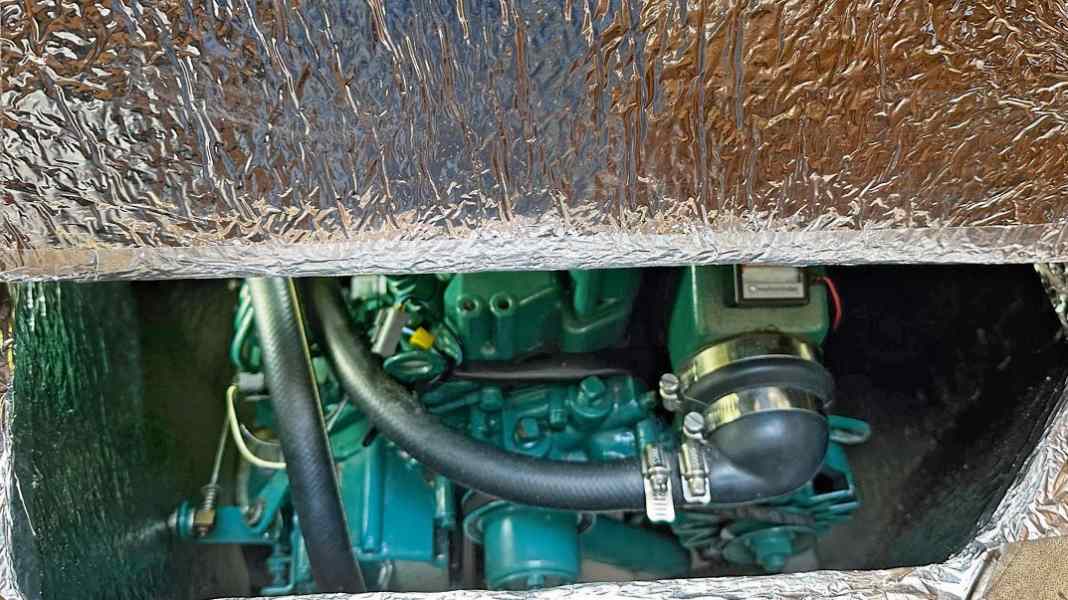
On most yachts, the engine compartment is lined on the inside with sound insulation. As the engine is usually installed very centrally in the boat, reducing the noise level is an important goal of this engine compartment insulation. But that's not all. A clean surface also ensures that unwanted leaks such as diesel, oil, cooling water or heavy abrasion from the V-belt are noticed more quickly. The surface should also be smooth and closed so that escaping fuel cannot be drawn into the foam. Otherwise there could be a fire hazard if the soaked insulation material were to ignite. The insulation must therefore fulfil several important tasks and serves both comfort and safety.
Why insulate the engine compartment?
It is primarily about sound insulation. How loud something is is specified in the unit Bel. The sound is divided into twelve levels (similar to the Beaufort scale). Starting with the hearing threshold, which is characterised as the dropping of a pin at a distance of one metre, up to a jackhammer at a distance of a few centimetres. Each stage represents a doubling of the volume. The jackhammer is therefore 4,096 times louder than the pin.
The sound energy increases by a factor of ten with each level. Each stage therefore corresponds to one bel or 10 decibels. With our diesel engine, the sound level is in the middle of the scale between 60 and 70 decibels. The difference between these two values corresponds to a tenfold increase in sound energy and a doubling of the volume. So every decibel makes a significant difference.
This is where the insulating material comes into play. It absorbs some of the energy of the sound waves and thus reduces the volume. The thicker the insulation, the better it works. In practice, however, there are structural limits here; the insulation cannot be thicker than a few centimetres.
However, it is also important that it is fitted over the entire surface. Because if sound can spread unhindered through gaps, even the best insulation won't help. Overlaps with bevelled edges can be useful here. However, there are also places, such as at the closures of moving parts, where a recess in the insulating material is unavoidable. This fine-tuning requires a little extra time when measuring and cutting.
Check old engine compartment insulation
We realised that the engine compartment insulation on board was not ideal during the first summer cruise with the boat we had bought second-hand. During a longer motor trip, we realised just how loud the engine really is when cruising. A closer inspection revealed that the insulation material was not ideally positioned. There were gaps between the insulation panels, particularly between the part of the engine compartment that is also the removable companionway steps and the side walls of the aft cabin and toilet room.
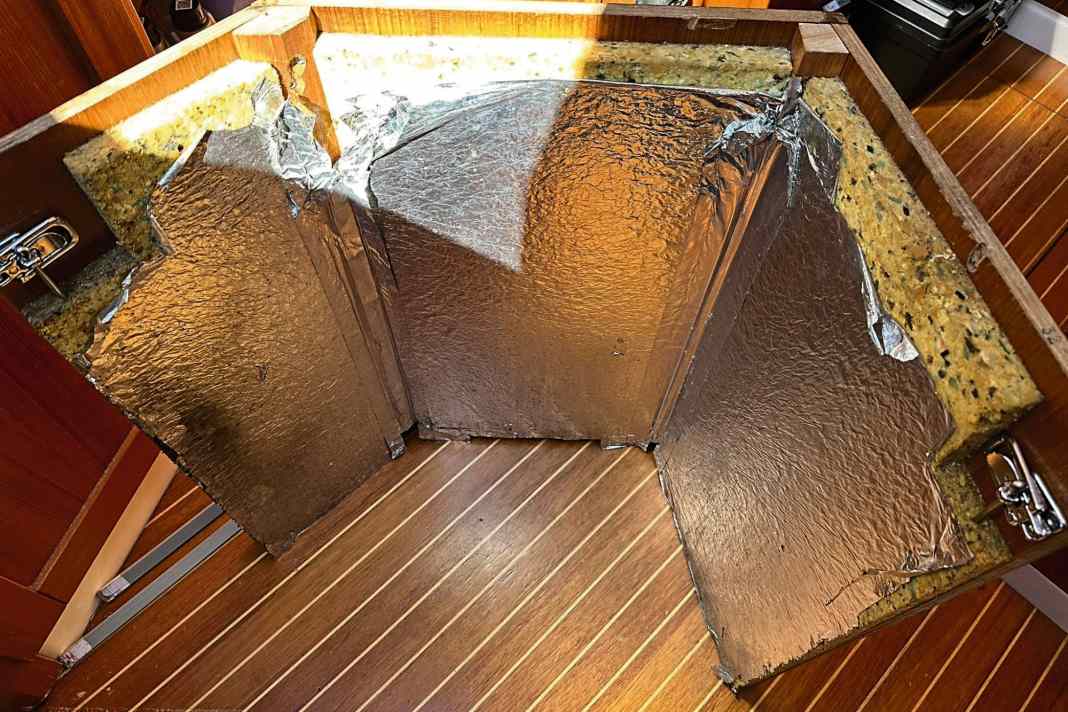



If the gaps were blocked with a towel, the noise was dampened somewhat. This was the first indication that better sound insulation would be worthwhile. In addition, the surface coating of the insulating material was already crumbling considerably and simply no longer looked good.
During a renovation, there was also some room to choose a ten millimetre thicker material. In other words, 30 instead of 20 millimetre thick insulation panels. Overall, the hope was that there was plenty of potential for improvement.
The right material for engine compartment insulation
For sound insulation, such as for interiors, there are materials that are designed to eliminate noise using tetrahedron-shaped studs. However, their surface is porous and therefore not suitable for engine compartment insulation. For this reason, a foam material sealed with aluminium foil was chosen.
Another point is the adhesive. For some materials, it must be applied separately. Panels with a self-adhesive backing are preferable. Then only the protective film needs to be removed for installation, which speeds up the work considerably. The material is available in 50 x 100 centimetre sheets from the company Isoflock from the wholesaler Gotthardt Yacht in Hamburg. According to the manufacturer, it is also fire-retardant. The material costs 40.50 euros per sheet.
When ordering, measurements must be taken in the machine room to estimate how many panels are required as replacements. Depending on the shape, there may be a lot of offcuts. It is important to consider whether some surfaces can be made up from smaller parts. However, this must not leave any gaps. The joints are no longer visible when covered with aluminium tape. The adhesive tape must be ordered anyway, as the manufacturer recommends sealing all open foam edges. A roll of aluminium tape costs just under 10 euros. With five panels, that adds up to around 213 euros.
Replacing engine compartment insulation step by step
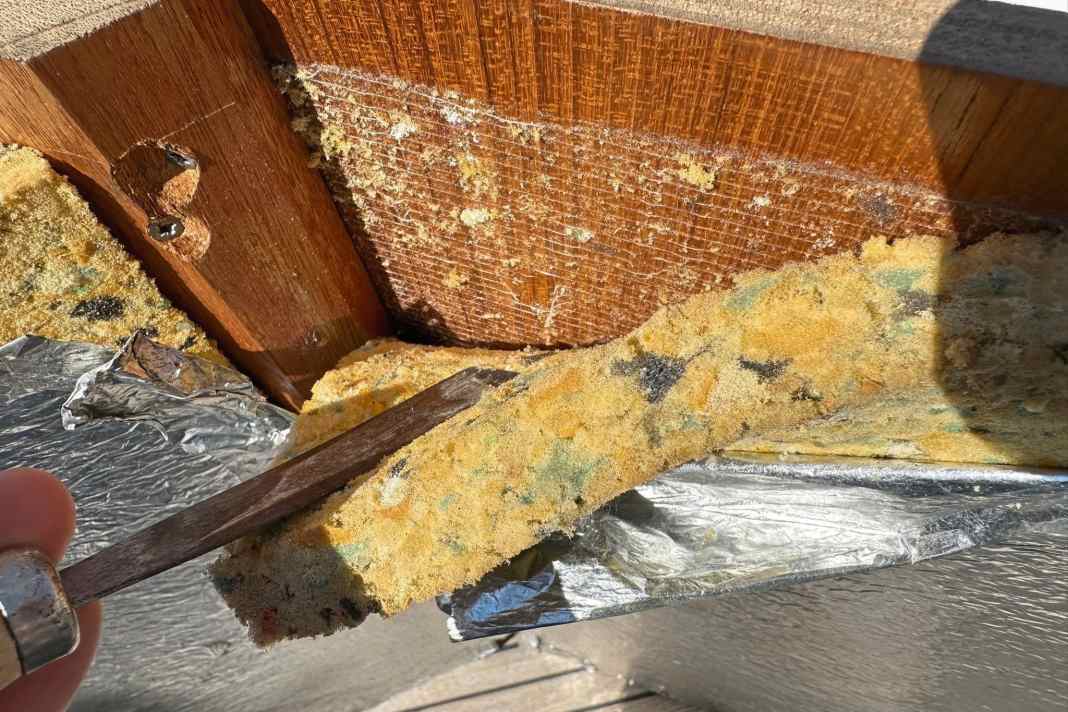





Remove old engine compartment insulation
The insulation was only replaced in the accessible area of the engine compartment. Directly behind the engine, for example, the material can only be replaced if the engine is removed. If major work is to be carried out on the diesel, it may make sense to replace the insulation directly if there is space in the engine compartment.
On the other hand, the coating also crumbles most in the areas where the engine compartment panelling is moved. And this front area is easily accessible for renewal, even with the diesel in place.
In addition, this example also revealed major gaps that are most worth closing.
The old insulation material can be easily removed by hand. A chisel or spatula can help. It turned out that the old adhesive still held very well and remained on the walls of the engine compartment together with a net-like carrier material. However, this cannot be avoided when tearing off the foam.
The entire renewal of the engine compartment insulation was completed by two people in one day. More than half of the time had to be planned for removing the old insulation. Although this work is no longer visible later, it is an important prerequisite for the new insulation material to hold in place.
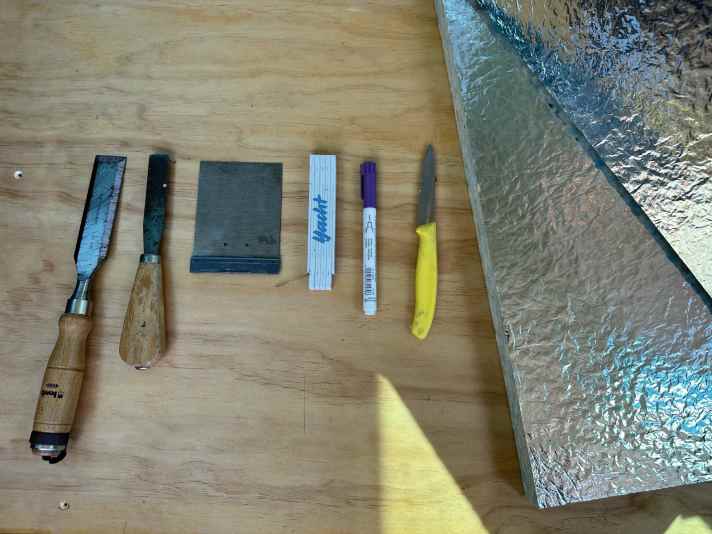
Remove adhesive residue
The adhesive residue must be removed to ensure that the new panels hold well. Scraping with a chisel is extremely tedious, as the adhesive coats the tool after just a few centimetres and makes it completely blunt. It is therefore advisable to use a cloth and solvent to dissolve the adhesive residue. The fabric, adhesive and adhering foam crumbs can then be scraped off with the chisel.
After this rather laborious process, however, the surface is still far from being completely free of adhesive residue. A further pass with a solvent is recommended. Acetone, for example, is suitable here. For parts of the engine compartment panelling that can be removed, it is advisable to carry out this work outdoors. The boat itself must be ventilated as well as possible and a breathing mask is mandatory.
Once the adhesive has been wetted with solvent a second time, you can now work with a wider spatula. The adhesive residue can be removed from the surface more easily. However, it is still helpful to clean the spatula regularly with solvent.
The work area should also be covered with foil beforehand, as any adhesive residue that may fall off is extremely stubborn on floorboards or in the engine bilge. It is also helpful to prepare a large plywood board as a work surface. This will help when cutting the insulation boards to size.
Take measurements and cut foam sheets to size
Measuring and cutting is quite simple and only requires a little more thought for moving parts such as flaps. Here, everything has to be as tight as possible, but still easy to open and close.
In addition, the previously existing gaps must be taken into account and planned more generously accordingly. Overlapping can be particularly useful at the points where the removable part of the companionway begins. To do this, the protruding part is scarfed at an angle. Precise measurements and a little judgement are required here. Mark with a waterproof marker. We have found that the top side with the aluminium foil is best suited for this. Don't worry: if something is marked incorrectly, the lines can simply be wiped away with the solvent.
When cutting the material, however, it is a decisive advantage to cut from above, because as soon as the knife comes into contact with the adhesive on the back, the blade sticks. As a result, the knife no longer cuts because the blade gets stuck. It is then helpful to regularly clean the blade with solvent. It makes cutting easier to cut from the top and not all the way through, then fold the material over at the cut edge and cut the last millimetre with the adhesive separately.
Stick on foam
Once a segment has been cut to size, do not remove the protective film directly from the adhesive surface, but first stop and check whether the corners fit exactly or whether cut-outs are necessary. If everything fits, you can stick it on. The adhesive adheres strongly, so for larger segments it is advisable to only peel off part of the protective film, align the corner, press on, then peel off the film piece by piece and continue gluing the panel in the meantime. This way you cannot accidentally stick it somewhere. The only thing left to do is to press the panel down properly over the entire surface and at the edges.
For more complicated shapes, a step-by-step procedure can be useful, i.e.: measure one segment, cut it to size, glue it on and then measure the next one and continue.
Mask edges and joints
The special aluminium tape is used for this purpose. It also has a protective film on the adhesive surface. This makes it easy to hold and cut to size before removing the film. For the lower edges, it may be easier to apply the tape before the foam segments are glued on. The areas are then difficult to access.
This is definitely the most beautiful part of the work. Even if one cut edge was a little jagged - now with the tape it is shiny silver and sleek. Visually, the engine room already makes a very good impression.
Is new engine compartment insulation worthwhile?
But what has the renewal of the engine compartment insulation achieved in terms of sound insulation? Do ten millimetres more material thickness and closed gaps have a positive effect on noise levels below deck when the engine is running? We measured the sound pressure before removing the old insulation.
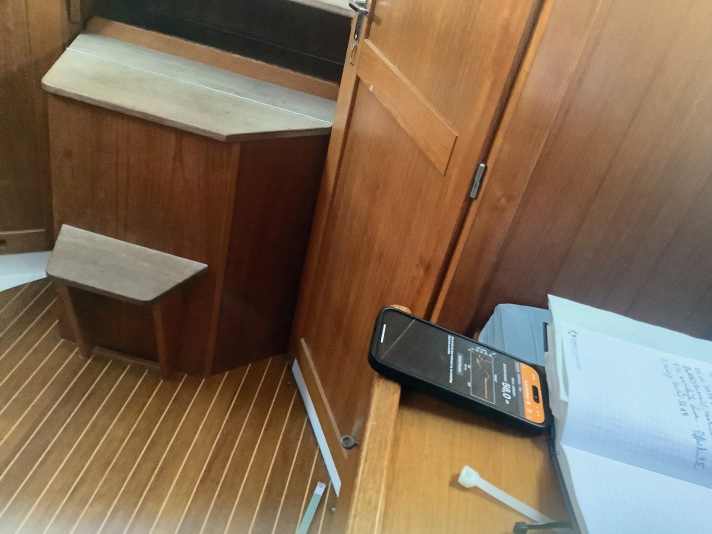
The measurement showed that the engine noise below deck has become quieter, as expected. The biggest change was seen at 1,500 revolutions with four decibels and 2,500 with two decibels less sound pressure. The sound energy was reduced by 75 per cent and the volume by around 25 per cent.
These are great values, but the engine is still clearly audible when cruising in the saloon, just not quite as loud as before. In addition, the engine compartment shines in new splendour, it is now really fun to work on the machine and you can even look forward to the next maintenance work. Find out which ones here Maintenance work are required for each season. We also have an overview for you of how the Cooling circuit should be examined.
Of course, in the best case scenario, you'll be sailing most of the time, but if the wind weakens and the engine has to be run for a few hours in the doldrums, it's easier to cope below deck.

